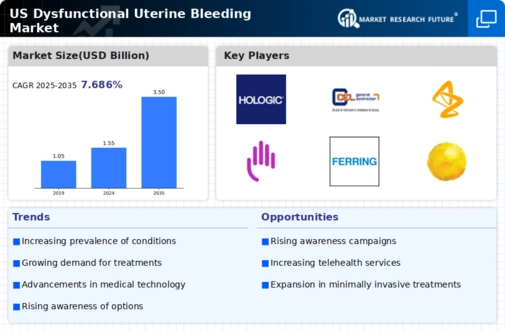Rising Healthcare Expenditure
The upward trend in healthcare expenditure in the US is positively impacting the dysfunctional uterine-bleeding market. Increased spending on healthcare services allows for greater investment in research and development of new treatments and technologies. As healthcare budgets expand, hospitals and clinics are better equipped to offer advanced therapies for conditions like dysfunctional uterine bleeding. This financial support is crucial for the dysfunctional uterine-bleeding market, as it fosters innovation and enhances patient access to effective treatments. Furthermore, the growing willingness of patients to invest in their health may lead to increased demand for specialized care, further driving market growth.
Advancements in Diagnostic Techniques
Recent advancements in diagnostic techniques are significantly influencing the dysfunctional uterine-bleeding market. Enhanced imaging technologies, such as transvaginal ultrasound and hysteroscopy, allow for more accurate identification of underlying causes of abnormal bleeding. These innovations not only improve patient outcomes but also facilitate timely interventions. The market is witnessing a shift towards minimally invasive diagnostic procedures, which are preferred by both patients and healthcare providers. As a result, the dysfunctional uterine-bleeding market is likely to expand, driven by the increasing adoption of these advanced diagnostic tools. Moreover, the integration of artificial intelligence in diagnostic processes may further streamline patient management, potentially increasing the market's value.
Increasing Prevalence of Uterine Disorders
The rising incidence of uterine disorders, including dysfunctional uterine bleeding, is a primary driver for the dysfunctional uterine-bleeding market. Studies indicate that approximately 30% of women experience some form of abnormal uterine bleeding during their reproductive years. This growing prevalence necessitates enhanced diagnostic and therapeutic options, thereby expanding the market. As healthcare providers increasingly recognize the need for effective management strategies, the demand for innovative treatments is likely to surge. Furthermore, the aging population in the US, which is more susceptible to such conditions, contributes to the market's growth. The dysfunctional uterine-bleeding market is thus positioned to benefit from this trend, as more women seek medical intervention for their symptoms.
Increased Focus on Women's Health Initiatives
The heightened focus on women's health initiatives is a significant driver for the dysfunctional uterine-bleeding market. Government and non-profit organizations are increasingly promoting awareness and education regarding women's health issues, including abnormal uterine bleeding. This emphasis on women's health is likely to lead to improved access to healthcare services and resources. As awareness grows, more women are likely to seek medical advice and treatment for their symptoms, thereby expanding the market. The dysfunctional uterine-bleeding market stands to benefit from this trend, as healthcare providers respond to the increasing demand for specialized care and support for women's health issues.
Growing Demand for Minimally Invasive Treatments
The rising preference for minimally invasive treatments is reshaping the dysfunctional uterine-bleeding market. Patients increasingly favor procedures that offer quicker recovery times and reduced complications. Techniques such as endometrial ablation and hysteroscopic myomectomy are gaining traction due to their effectiveness and lower risk profiles. According to recent data, minimally invasive procedures account for over 60% of all surgical interventions for uterine conditions. This trend is likely to continue, as more women seek alternatives to traditional surgical methods. Consequently, the dysfunctional uterine-bleeding market is expected to experience growth as healthcare providers adopt these innovative treatment options to meet patient demands.





















Leave a Comment